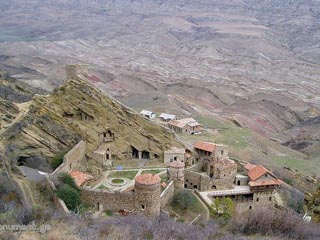May 18, 2012
 |
| The Monastery of St. David of Garedji. |
Portion of Davit Gareji complex with its cave monasteries is one of the major stumbling blocks in border demarcation talks ongoing for many years already between Georgia and Azerbaijan.
During the Soviet times the monastery complex was split by administrative border with major part of the complex falling within Georgia and another portion within Azerbaijan. Since the collapse of the Soviet Union the two countries have been trying in vain to agree on the border demarcation.
The monastery complex, construction of which started in 6th century, is located in Gareji semi-desert about 70 kilometers southeast of Tbilisi and is one of Georgia’s important cultural and religious heritage sites and home of Georgian Orthodox monks.
Historical aspect of the area is also mentioned by some Azerbaijani commentators when addressing the dispute; in particular, some Azerbaijani historians argue, that the area was part of the territory, which was home to the Caucasian Albanians, who are believed to have been the earliest inhabitants of Azerbaijan. This historical context was raised at least once publicly by the Azerbaijani Foreign Ministry official back in 2007, triggering Tbilisi’s protest against bringing into border talks “debate of historical nature”. That public verbal exchange between the officials of two countries was a notably rare exception as both sides have always been tending not to overshadow “strategic” relations by this dispute.
Probably more important aspect of the dispute, at least for Azerbaijan, is the fact that the area in question occupies high ground causing its strategic importance as territories of both Azerbaijan and Georgia can been well monitored from that ridge.
Until May 6, 2012 visitors from Georgia were able to freely access part of complex, including the Udabno monastery, made up of caves cut into the rocks across the ridge.
But from May 6 Azerbaijani border guards redeployed, no longer allowing visitors to access the area. Local Orthodox monks, however, were still able to move unhindered.
Maestro TV broke the news about it on May 11 after receiving this information from local monks. The issue was picked up on by opposition coalition Georgian Dream, whose one of the members Zviad Dzidziguri of Conservative Party traveled to the area on May 13. Next day he alleged that the move by the Azerbaijani border guards was probably not unilateral decision and accused the Georgian authorities of a “secret agreement” with Azerbaijan.
The issue drew more controversy internally in Georgia after its Deputy Foreign Minister, Nino Kalandadze, said that the portion of the monastery complex in question was not in fact “a disputed territory”, because during the Soviet times it was within the Azerbaijani borders.
She said at a news conference on May 14, that the Foreign Ministry was aware about visitors being barred from entering into the one portion of the monastery complex and was “concerned” with such a development, adding that Tbilisi was in contact with Baku to resolve the issue.
Kalandadze said: “This particular portion of the Gareji complex, which has become source of problem, has not been part of Georgia from the Soviet times. Delimitation issue has been more or less successful so far and I hope it will be completed soon and there will be no disputed territories any more. But this particular portion does not belong to the disputed territories.”
The statement came as a surprise, triggering wave of criticism from some opposition groups, as well as from the Georgian Orthodox Church. Mikael Botkoveli, secretary of Georgian Orthodox Church Patriarch Ilia II, said this statement by the Deputy Foreign Minister that those territories were not disputed amounted to “pouring cold water on us.”
On May 16 Deputy Foreign Minister Nino Kalandadze tried to clarify her remarks, saying that she was misunderstood. Kalandadze acknowledged in an interview with Tbilisi-based Palitra radio station, that misunderstanding could have possibly been caused partly by her failure to articulate position properly.
She said that 66% of Georgian-Azerbaijani border had been agreed by the two countries so far in frames of border talks. She also said that about 2% of the entire David Gareji monastery complex was among those portions of border which had yet to be agreed with Azerbaijan and that included Udabno monastery too.
On May 17 a phone conversation was held between Georgian and Azerbaijani Foreign Ministers, Grigol Vashadze and Elmar Mammadyarov, respectively.
The two ministers “discussed various topical issues concerning bilateral relations between their two countries, and also focused on the problem of the Udabno monastery… which arose as a result of the recent rerouting of Azerbaijani border guards patrolling the area,” the Georgian Foreign Ministry said in a statement on May 17.
“Determined to keep in constant contact, the Ministers agreed to give further consideration to this matter at the meeting they plan to hold during the Chicago NATO Summit. Representatives of the border services of both countries are also to remain in constant touch with each other,” it said.
In 2006 there have been reports that Georgia was offering Azerbaijan to make an exchange with Tbilisi gaining disputed portion of the monastery complex in exchange of giving to Azerbaijan portion of land in other border areas. At the time Azerbaijani officials were publicly denouncing such option saying land exchange was unacceptable.
